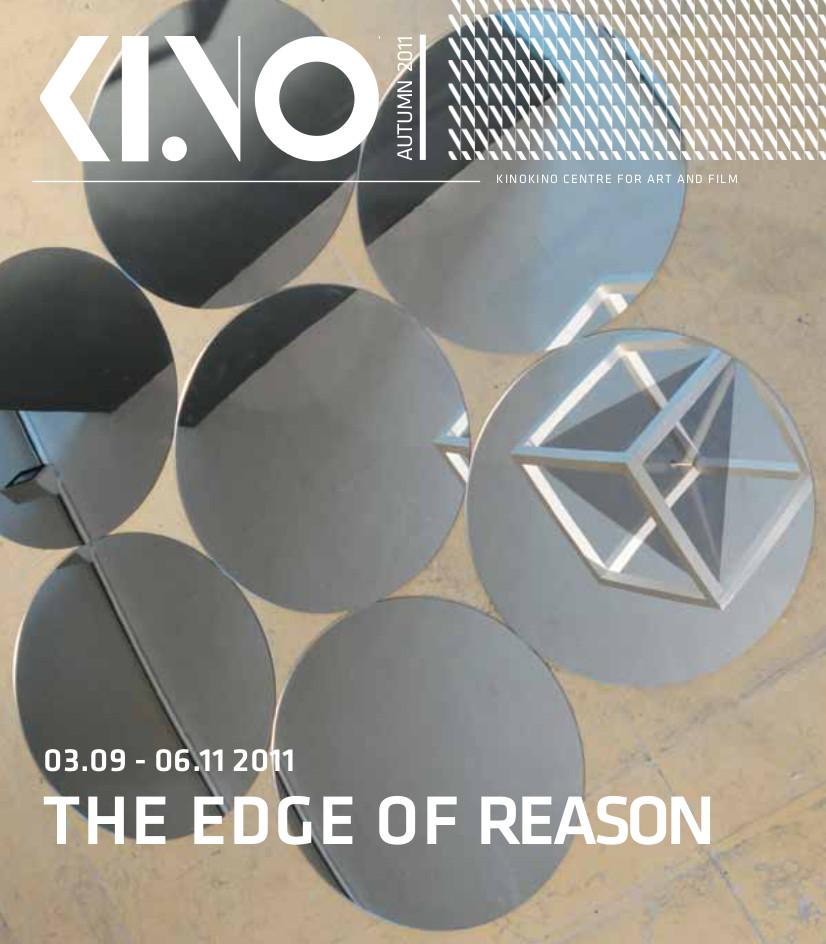The Edge of Reason, catalogue (2011)
Filed under catalogue | Tags: · art, irrational, mysticism, occultism, rationalism, science

The exhibition The Edge of Reason, curated by Norwegian and London-based artists Sidsel Christensen and Ben Judd in 2011 in the KinoKino centre in Sandnes, Norway, explored notions of authenticity and belief, inviting viewer to have a first-hand experience of a world beyond the senses.
Christensen and Judd invited artists whose work helps to trace a historical overlapping in the development of the empirical and scientific with the irrational and mystical. The artists in the exhibition presented a duality of experience, by moving in-between a sceptical enquiry and a more internalised visionary engagement to explore the unknown.
Artists: Sidsel Christensen, Marcus Coates, Maya Deren, George Gurdjieff, Susan Hiller, Ben Judd, Hilma af Klint, Susan MacWilliam, Oscar Muñoz, Karen Russo (with Jeremy Millar, Shezad Dawood, Mark Titchner), Jane and Louise Wilson.
The catalogue contains transcript of a 2011 séance contacting the Swedish pioneer of abstract art and mystic Hilma af Klint (1862—1944; pages 16-23).
Publisher KinoKino Centre for Art and Film, Sandnes, Norway, 2011
56 pages
Amelia Jones: Irrational Modernism: A Neurasthenic History of New York Dada (2004)
Filed under book | Tags: · 1910s, 1920s, art, art history, avant-garde, dada, irrational

In Irrational Modernism, Amelia Jones gives us a history of New York Dada, reinterpreted in relation to the life and works of Baroness Elsa von Freytag-Loringhoven. Jones enlarges our conception of New York Dada beyond the male avant-garde heroics of Marcel Duchamp, Man Ray, and Francis Picabia to include the rebellious body of the Baroness. If they practiced Dada, she lived it, with her unorthodox personal life, wild assemblage objects, radical poetry and prose, and the flamboyant self-displays by which she became her own work of art. Through this reinterpretation, Jones not only provides a revisionist history of an art movement but also suggests a new method of art history.
Jones argues that the accepted idea of New York Dada as epitomized by Duchamp’s readymades and their implicit cultural critique does not take into consideration the contradictions within the movement—its misogyny, for example—or the social turmoil of the period caused by industrialization, urbanization, and the upheaval of World War I and its aftermath, which coincided with the Baroness’s time in New York (1913-1923). Baroness Elsa, whose appearances in Jones’s narrative of New York Dada mirror her volcanic intrusions into the artistic circles of the time, can be seen to embody a new way to understand the history of avant-gardism—one that embraces the irrational and marginal rather than promoting the canonical.
Acknowledging her identification with the Baroness (as a “fellow neurasthenic”), and interrupting her own objective passages of art historical argument with what she describes in her introduction as “bursts of irrationality,” Jones explores the interestedness of all art history, and proposes a new “immersive” understanding of history (reflecting the historian’s own history) that parallels the irrational immersive trajectory of avant-gardism as practiced by Baroness Elsa.
Publisher MIT Press, 2004
ISBN 0262101025, 9780262101028
344 pages
PDF (updated on 2012-11-19)
Comment (1)Theodor W. Adorno: Adorno: The Stars Down to Earth and Other Essays on the Irrational in Culture (1994)
Filed under book | Tags: · anti-semitism, astrology, culture, fascism, irrational, occultism, psychoanalytics

The Stars Down to Earth shows us a stunningly prescient Adorno. Haunted by the ugly side of American culture industries he used the different angles provided by each of these three essays to showcase the dangers inherent in modern obsessions with consumption. He engages with some of his most enduring themes in this seminal collection, focusing on the irrational in mass culture – from astrology to new age cults, from anti-semitism to the power of neo-fascist propaganda. He points out that the modern state and market forces serve the interest of capital in its basic form. Stephan Crook’s introduction grounds Adorno’s arguments firmly in the present where extreme religious and political organizations are commonplace – so commonplace in fact that often we deem them unworthy of our attention. Half a century ago Theodore Adorno not only recognised the dangers, but proclaimed them loudly. We did not listen then. Maybe it is not too late to listen now.
Edited with an Introduction by Stephen Crook
Publisher Routledge, 1994
Routledge classics
ISBN 0415105684, 9780415105682
176 pages
PDF (updated on 2013-6-6)
Comment (1)
